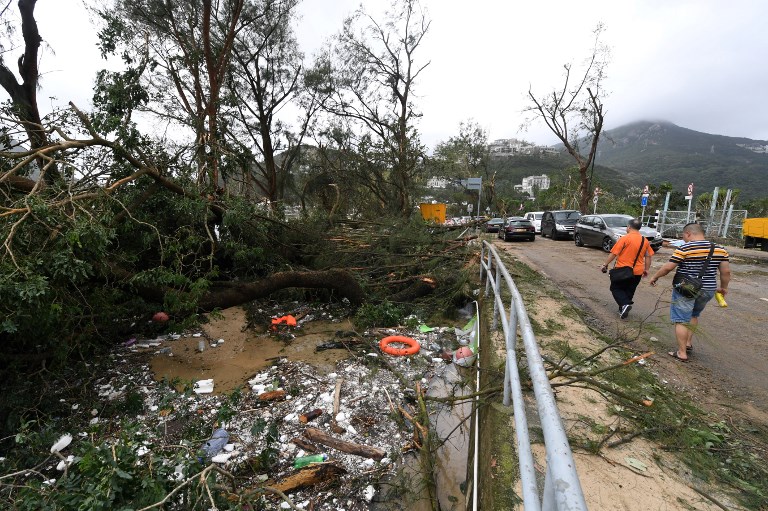
People walk past debris washed up next to a road at Deep Water Bay in the aftermath of Typhoon Mangkhut in Hong Kong on September 17, 2018. AFP PHOTO / Mark RALSTON
HONG KONG — Hong Kong began a massive cleanup on Monday after Typhoon “Mangkhut” raked the city, shredding trees and flooding roads, in a trail of destruction that left dozens dead in the Philippines and millions evacuated in southern China.
After tearing through Luzon and pummeling Hong Kong and Macau, the powerful storm made landfall in mainland China late Sunday, killing four in Guangdong province, including three hit by falling trees.
Authorities there said they had evacuated more than 3 million people and ordered tens of thousands of fishing boats back to port before the arrival of what the Chinese media had dubbed the “King of Storms.”
In the high-rise city of Hong Kong, the government described the damage as “severe and extensive” with more than 300 people injured by Mangkhut, which triggered the maximum Storm Signal No. 10.
Among those injured was a Filipino tourist who underwent leg surgery after she was hit by flying debris, the Department of Foreign Affairs reported in Manila. About 227,000 Filipinos live in Hong Kong.
The monumental task of cleaning up the city began as residents, some in suits and ties, struggled to get back to work on roads that remained blocked by felled trees, mud and debris.
Schools closed, bus services halted, and commuters piled onto platforms trying to board infrequent trains after trees fell on overhead lines.
Landslides and severe flooding affected some areas, with over 1,500 residents seeking refuge in temporary shelters overnight.
Floods and debris
Mangkhut, with gusts of more than 230 kilometers per hour, sent buildings swaying and waters surging into homes and shopping malls in Hong Kong, with some roads waist-deep in water.
The windows of many tower blocks and skyscrapers were smashed as people cowered inside.
At the Heng Fa Chuen neighborhood in Chai Wan, thousands of rocks and pebbles from the sea covered parkland along the coastline that had been battered by waves.
Seawater swamped low-lying fishing villages. Residents picked their way through streets at the seaside village of Lei Yue Mun, which was covered in debris and glass.
The city’s main Victoria Park had become an obstacle course with hundreds of trees down and many completely uprooted.
Emergency teams were sawing apart some of the biggest trees blocking roads and pathways across the city in a cleanup operation likely to take days.
Casinos reopen
In the neighboring gambling enclave of Macau, all 42 casinos shut down for the first time in its history as the storm approached.
The casinos reopened on Monday, even though Macau was still in recovery mode after severe flooding hit parts of the city. Using boats and Jet Skis, emergency workers rescued people from their shops and homes at the height of the storm.
As Mangkhut moved past the enclave on Sunday, water gushed in from the harbor and submerged streets.
On Monday morning, Macau shopkeepers hosed down their stores that had been left caked in mud after the floodwaters receded.
People dried out cupboards and electrical appliances on the streets as police and volunteers helped with the cleanup.
The government and casinos took extra measures ahead of the storm, determined to avoid a repeat of last year’s Typhoon “Hato” that battered Macau, left 12 people dead and drew accusations the city was ill-prepared.
‘I didn’t dare go out’
In Guangdong province, trees fell and some streets experienced ankle-level flooding.
Residents at Yashao village moved debris and branches off the roads for collection by a rubbish truck. A large propaganda billboard was blown down on the side of the road.
“I was scared. I didn’t dare go out last night. At one point the flooding was this high,” villager Zhen Jingli, 62, said as he pointed to his waist. —Reports from AFP and Dona Pazzibugan in Manila